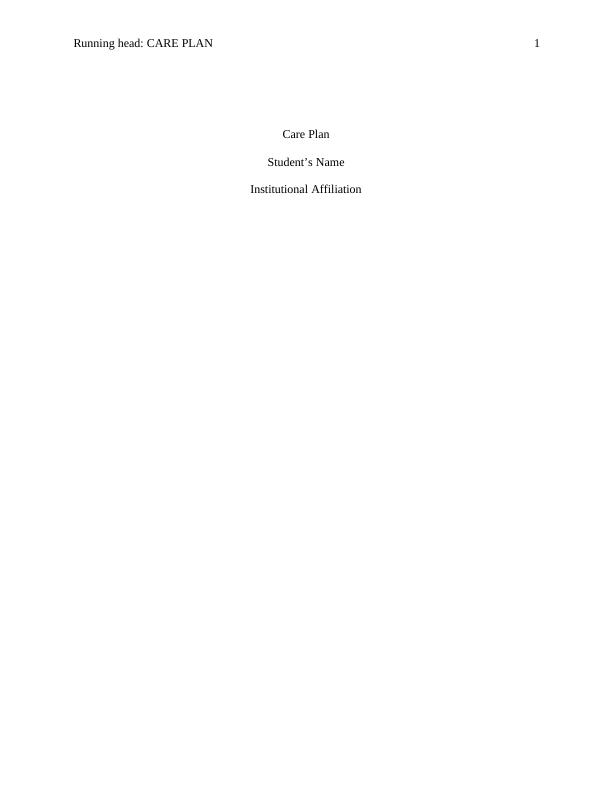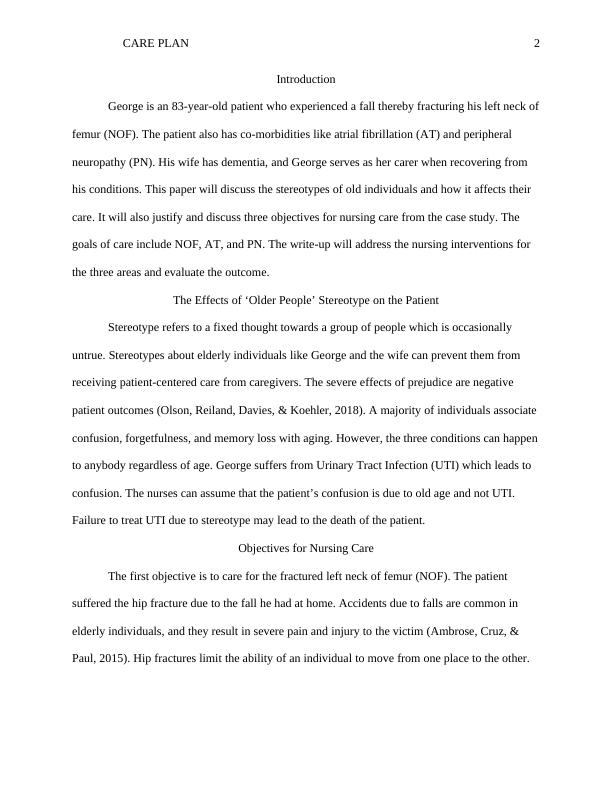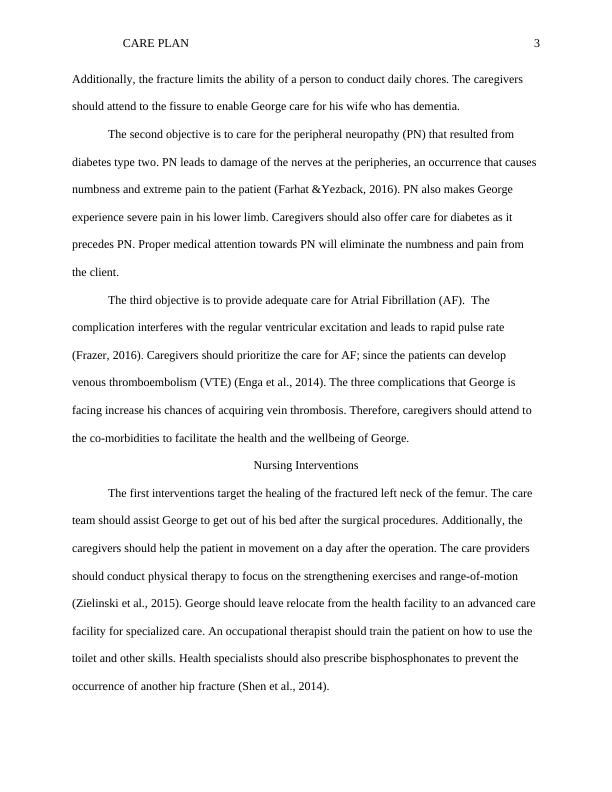Ask a question from expert
Nursing Care Case Study : Assignment
7 Pages1860 Words37 Views
Added on 2021-09-19
Nursing Care Case Study : Assignment
Added on 2021-09-19
BookmarkShareRelated Documents
Running head: CARE PLAN 1
Care Plan
Student’s Name
Institutional Affiliation
Care Plan
Student’s Name
Institutional Affiliation

CARE PLAN 2
Introduction
George is an 83-year-old patient who experienced a fall thereby fracturing his left neck of
femur (NOF). The patient also has co-morbidities like atrial fibrillation (AT) and peripheral
neuropathy (PN). His wife has dementia, and George serves as her carer when recovering from
his conditions. This paper will discuss the stereotypes of old individuals and how it affects their
care. It will also justify and discuss three objectives for nursing care from the case study. The
goals of care include NOF, AT, and PN. The write-up will address the nursing interventions for
the three areas and evaluate the outcome.
The Effects of ‘Older People’ Stereotype on the Patient
Stereotype refers to a fixed thought towards a group of people which is occasionally
untrue. Stereotypes about elderly individuals like George and the wife can prevent them from
receiving patient-centered care from caregivers. The severe effects of prejudice are negative
patient outcomes (Olson, Reiland, Davies, & Koehler, 2018). A majority of individuals associate
confusion, forgetfulness, and memory loss with aging. However, the three conditions can happen
to anybody regardless of age. George suffers from Urinary Tract Infection (UTI) which leads to
confusion. The nurses can assume that the patient’s confusion is due to old age and not UTI.
Failure to treat UTI due to stereotype may lead to the death of the patient.
Objectives for Nursing Care
The first objective is to care for the fractured left neck of femur (NOF). The patient
suffered the hip fracture due to the fall he had at home. Accidents due to falls are common in
elderly individuals, and they result in severe pain and injury to the victim (Ambrose, Cruz, &
Paul, 2015). Hip fractures limit the ability of an individual to move from one place to the other.
Introduction
George is an 83-year-old patient who experienced a fall thereby fracturing his left neck of
femur (NOF). The patient also has co-morbidities like atrial fibrillation (AT) and peripheral
neuropathy (PN). His wife has dementia, and George serves as her carer when recovering from
his conditions. This paper will discuss the stereotypes of old individuals and how it affects their
care. It will also justify and discuss three objectives for nursing care from the case study. The
goals of care include NOF, AT, and PN. The write-up will address the nursing interventions for
the three areas and evaluate the outcome.
The Effects of ‘Older People’ Stereotype on the Patient
Stereotype refers to a fixed thought towards a group of people which is occasionally
untrue. Stereotypes about elderly individuals like George and the wife can prevent them from
receiving patient-centered care from caregivers. The severe effects of prejudice are negative
patient outcomes (Olson, Reiland, Davies, & Koehler, 2018). A majority of individuals associate
confusion, forgetfulness, and memory loss with aging. However, the three conditions can happen
to anybody regardless of age. George suffers from Urinary Tract Infection (UTI) which leads to
confusion. The nurses can assume that the patient’s confusion is due to old age and not UTI.
Failure to treat UTI due to stereotype may lead to the death of the patient.
Objectives for Nursing Care
The first objective is to care for the fractured left neck of femur (NOF). The patient
suffered the hip fracture due to the fall he had at home. Accidents due to falls are common in
elderly individuals, and they result in severe pain and injury to the victim (Ambrose, Cruz, &
Paul, 2015). Hip fractures limit the ability of an individual to move from one place to the other.

CARE PLAN 3
Additionally, the fracture limits the ability of a person to conduct daily chores. The caregivers
should attend to the fissure to enable George care for his wife who has dementia.
The second objective is to care for the peripheral neuropathy (PN) that resulted from
diabetes type two. PN leads to damage of the nerves at the peripheries, an occurrence that causes
numbness and extreme pain to the patient (Farhat &Yezback, 2016). PN also makes George
experience severe pain in his lower limb. Caregivers should also offer care for diabetes as it
precedes PN. Proper medical attention towards PN will eliminate the numbness and pain from
the client.
The third objective is to provide adequate care for Atrial Fibrillation (AF). The
complication interferes with the regular ventricular excitation and leads to rapid pulse rate
(Frazer, 2016). Caregivers should prioritize the care for AF; since the patients can develop
venous thromboembolism (VTE) (Enga et al., 2014). The three complications that George is
facing increase his chances of acquiring vein thrombosis. Therefore, caregivers should attend to
the co-morbidities to facilitate the health and the wellbeing of George.
Nursing Interventions
The first interventions target the healing of the fractured left neck of the femur. The care
team should assist George to get out of his bed after the surgical procedures. Additionally, the
caregivers should help the patient in movement on a day after the operation. The care providers
should conduct physical therapy to focus on the strengthening exercises and range-of-motion
(Zielinski et al., 2015). George should leave relocate from the health facility to an advanced care
facility for specialized care. An occupational therapist should train the patient on how to use the
toilet and other skills. Health specialists should also prescribe bisphosphonates to prevent the
occurrence of another hip fracture (Shen et al., 2014).
Additionally, the fracture limits the ability of a person to conduct daily chores. The caregivers
should attend to the fissure to enable George care for his wife who has dementia.
The second objective is to care for the peripheral neuropathy (PN) that resulted from
diabetes type two. PN leads to damage of the nerves at the peripheries, an occurrence that causes
numbness and extreme pain to the patient (Farhat &Yezback, 2016). PN also makes George
experience severe pain in his lower limb. Caregivers should also offer care for diabetes as it
precedes PN. Proper medical attention towards PN will eliminate the numbness and pain from
the client.
The third objective is to provide adequate care for Atrial Fibrillation (AF). The
complication interferes with the regular ventricular excitation and leads to rapid pulse rate
(Frazer, 2016). Caregivers should prioritize the care for AF; since the patients can develop
venous thromboembolism (VTE) (Enga et al., 2014). The three complications that George is
facing increase his chances of acquiring vein thrombosis. Therefore, caregivers should attend to
the co-morbidities to facilitate the health and the wellbeing of George.
Nursing Interventions
The first interventions target the healing of the fractured left neck of the femur. The care
team should assist George to get out of his bed after the surgical procedures. Additionally, the
caregivers should help the patient in movement on a day after the operation. The care providers
should conduct physical therapy to focus on the strengthening exercises and range-of-motion
(Zielinski et al., 2015). George should leave relocate from the health facility to an advanced care
facility for specialized care. An occupational therapist should train the patient on how to use the
toilet and other skills. Health specialists should also prescribe bisphosphonates to prevent the
occurrence of another hip fracture (Shen et al., 2014).

End of preview
Want to access all the pages? Upload your documents or become a member.
Related Documents
Pulmonary embolism: Pathophysiology and the formation of an embolismlg...
|11
|1872
|397